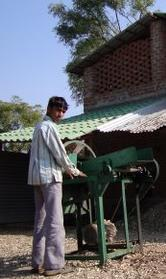|
Energy, Agriculture, Environment -
I n the Indian context, agriculture is considered to be synonymous with ‘rural’, where agricultural
mechanisation is not much advanced. It is commonly believed that
agriculture is one of the main power consuming sectors. There is huge
demand of energy for pumping groundwater for irrigation. Hence you have
the quite inextricable interconnections between energy, water and
environment sustainability. agricultural
mechanisation is not much advanced. It is commonly believed that
agriculture is one of the main power consuming sectors. There is huge
demand of energy for pumping groundwater for irrigation. Hence you have
the quite inextricable interconnections between energy, water and
environment sustainability. India has emerged as the largest extractor of groundwater in the world, pumping 250 cubic km of groundwater a year. Groundwater irrigation may have helped the nation to achieve self-sufficiency, and contribute to the creation of wealth in rural areas. While a thriving groundwater economy has invigorated rural economies, such high and unregulated extractions of groundwater are seriously threatening the sustainability of the groundwater economy itself. Additionally, in the absence of reliable power supply the majority of farmers are dependent on diesel pump sets for irrigation. The diesel engines used are quite inefficient, causing serious environmental implications. At the same time it causes additional financial burden on farmers. A primary survey of DA archives in Bundelkhand region reveals that it costs approx Rs 20 per unit of energy generated by such diesel pump sets. This cost is almost the ten times the unit cost of electricity supplied by state electricity board for agricultural purposes. Development Alternatives Initiative In order to respond to this situation Development Alternatives (DA) has undertaken a few pilot initiatives. One of such project is Biomass Powered Energy Services in Radhapur Village of Shivpuri District M.P, in collaboration with the Department of Science and Technology, GOI. This village was never before connected to grid supply. The village has a population of 456 across 85 households. Village economy is dependent on agriculture; 120 acres of land is under agriculture. Diesel was primary source of fuel for irrigation and kerosene for domestic lightning. From May 2009 onwards, community managed biomass gasifier – engine plant of 10 kW capacity is energising six electric pumps for irrigation and meeting domestic load demand for 22 households. The farmers are being introduced to efficient irrigation practices such as drip irrigation, sprinkler etc. Village Energy Committee (VEC) with representative social participation and women members has been efficiently handling plant management and has opened its own bank account. As the farmers and families are paying for the electricity, the running costs of the facility is covered, thereby ensuring that it is self sustaining The plant operator too is from the village and is paid a monthly salary by the VEC. Although these six pump sets, getting electricity by biomass gasifier, constitute only one – fifth of the total number of pumps used in peak irrigation season, this is a significant step in understanding the functioning of such a system on the ground. Farmers are more acceptable to adopt efficient irrigation practices as they see immediate financial benefits in using electricity for irrigation. Way Forward There is a huge potential to replicate such models. It addresses the issue of the energy starved agricultural sector, the economy of the rural household dependent on agriculture, the issue of farmers turning to resource-conserving measures and the subsequent implications on environment. Proper support of government policies is required to take these measures to a larger scale. Simultaneously there is need to build vibrant rural communities for whom agriculture becomes a rewarding way of life. Collective effort is required to move in this direction and adapt these models for sustainable development of society. q Sonika Choudhary |